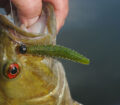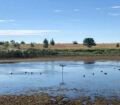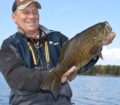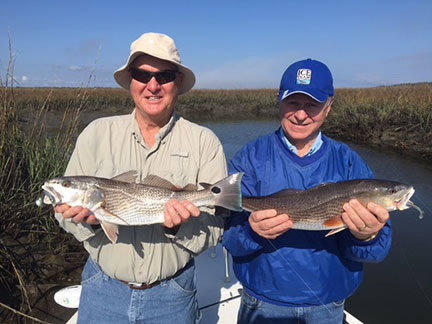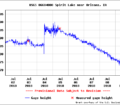By Steve Weisman
Outdoor Editor
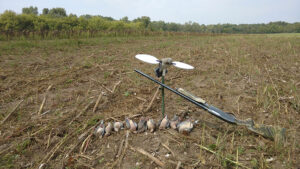
(photo by Lowell Washburn) – A spinner decoy increases the chances of bagging doves.
As we head into the month of August, we begin to look forward to school and fall activities starting, September 1 actually kicks off two early hunting seasons – the dove season and the teal season. First off, let’s take a look at the dove season.
12th year of dove hunting in Iowa
It’s hard to believe that Iowa has now had a dove season for 12 years. In addition to the mourning dove, there is also the Eurasian collard-dove that can be legally bagged. Dove season is Sept. 1 to Nov. 29, with a daily bag limit of 15 doves, and possession limit of 45.
Shooting hours are one-half hour before sunrise to sunset. Hunters must have a plug in their shotgun limiting them to three shells just as they would during the waterfowl season. Hunters must register with the Harvest Information Program before they go hunting.
Hunting doves is pretty simple: just you, a shotgun, lots and lots of shells, a bucket to sit on and to carry out the bagged doves and a spot that has doves using the area you plan on hunting.
Scouting
This is especially important for dove hunters. Even though they are pretty much anywhere, you will find concentrations of doves in certain areas. When scouting, try to check your potential hunting spots in the early morning and early evening and try to figure out their flight pattern.
Mourning doves prefer feeding on open ground and eat a variety of seeds and grains. As a result, several DNR wildlife areas in each county have food plots that have been planted to attract doves. Portions of these food plots will be cut down/disked a few days prior to the season to help attract doves to the area. The Iowa DNR has a list of public wildlife areas and private land enrolled in Iowa Habitat Access Program (IHAP) where dove plots (primarily sunflowers) have been added. These opportunities are thanks to landowners who participate in the Iowa Habitat and Access (IHAP) program.
To find these food plot areas, just go to the Iowa DNR website, click on hunting and search for mourning dove hunting in Iowa. There, you will find a PDF of “Food Plot Sites” by county.
HAP areas in close-by counties include the following:
- Clay – Barringer Slough and Little Sioux
- Dickinson – Cayler Prairie, Christopherson Slough, Diamond Lake, Kettleson-Hogsback Complex, Spring Run Complex
- Emmet – Anderson Prairie Complex, Ingham-High Wetland Complex
- O’Brien – Crosbie Wildlife, Hagen Wildlife Area, Hannibal Waterman Wildlife Area, Waterman Creek, Waterman Prairie
- Palo Alto – Dewey’s Pasture, Fallow Marsh, West Fork
A great spot
An ideal hunting spot would be a harvested/disked sunflower field, a supply of water (pond or slough) in the area and a nearby roosting area. Check to see what hiding spots are available. Standing corn? Standing sunflowers? Good fence line cover? Some tall grass prairie? Maybe a thicket or tree?
If you will be hunting on public land, you can expect to find multiple hunting groups in the same field. So, plan on getting to your favorite spot early to beat the crowd. Don’t expect to just show up at shooting time. Best hunting times are early morning (the first two hours) and early evening (the last 1-2 hours). If you can find a good private area, that will take care of the competition issue.
The hunt
Get there early. The doves will be moving at first light. When the doves do come through, expect them to come zipping through like little acrobats. If there are lots of birds in the area, expect to go through at least a box of shells or more during a hunt. Many a so-called expert marksman has been humbled by these fast flying doves. Unless you have a dog with you to retrieve downed birds, make sure to mark the downed bird. A good hunting dog will mark and then find downed birds.
Registering for HIP
All dove hunters are required to register with the Harvest Information Program (HIP). The Harvest Information Program (HIP) is a partnership between the U.S. Fish and Wildlife Service and state wildlife agencies to collect information on the nation’s migratory game bird hunters and their harvest of migratory game birds. ALL migratory game bird hunters are required to register with HIP prior to hunting. Only one HIP # is needed for those who hunt all migratory birds.

